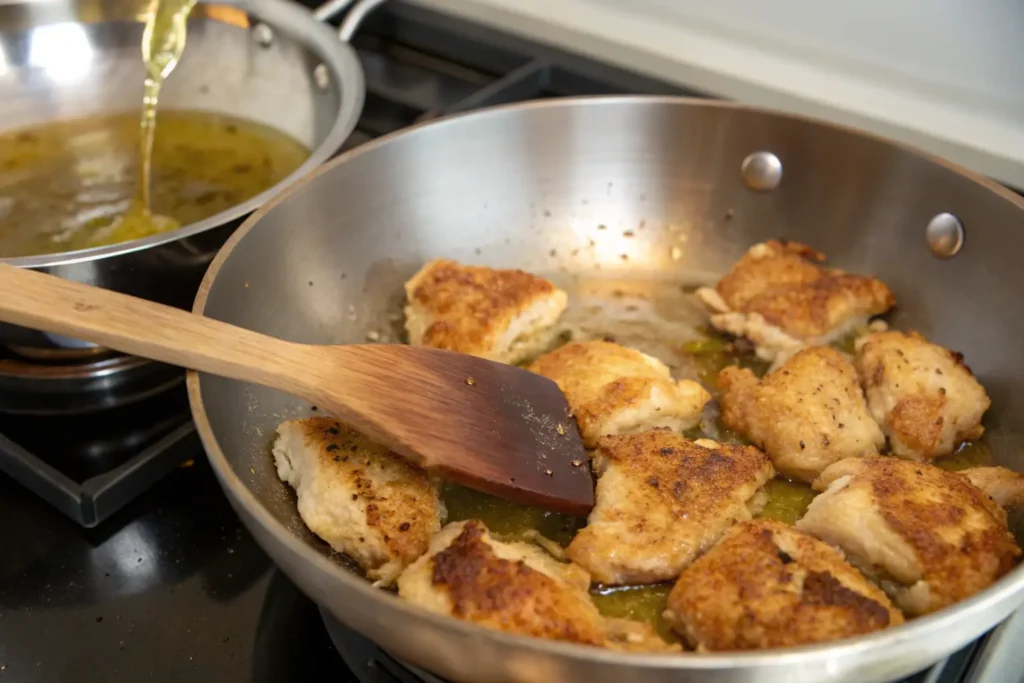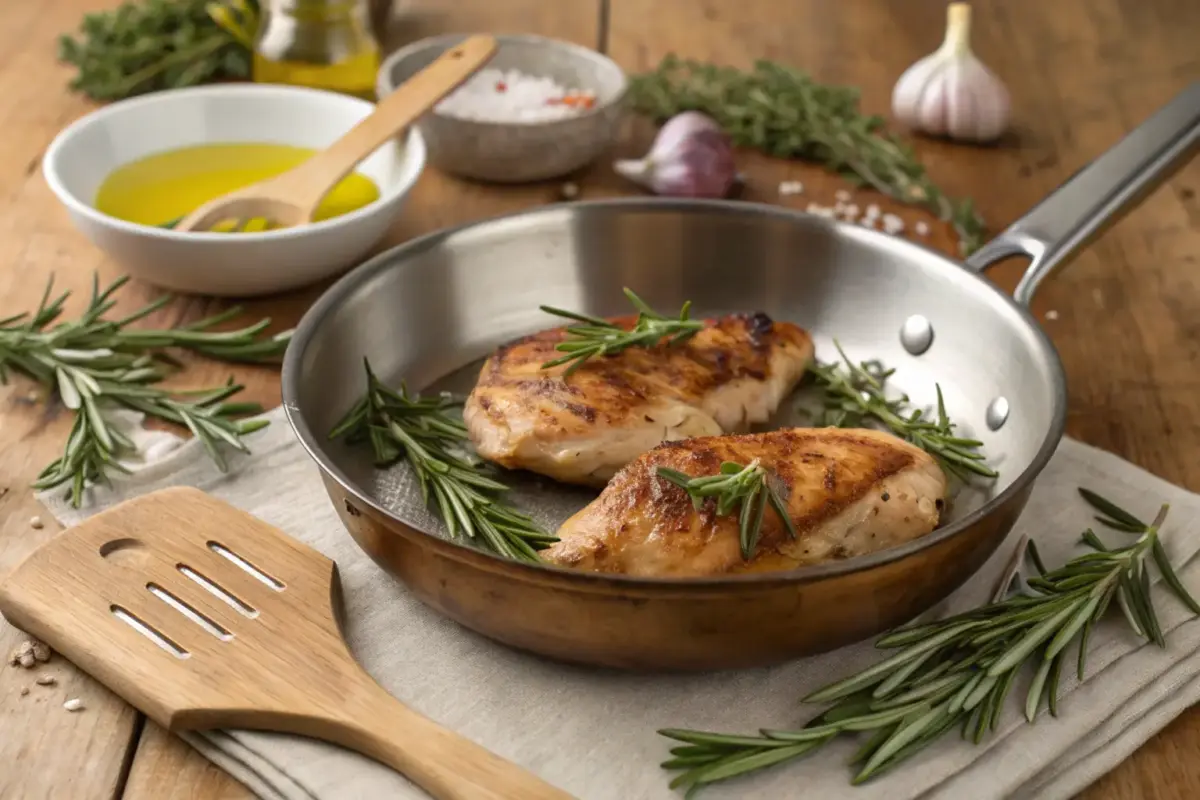Introduction
Let’s face it—sautéing chicken is one of those essential kitchen skills every home cook should master. Whether you’re whipping up a quick dinner or adding some protein to your meal prep, knowing how to sauté chicken the right way can make all the difference. But what’s the secret? Well, it’s not as tricky as it seems! In this guide, I’ll break down everything you need to know, step by step. So grab your skillet, and let’s get cooking. For those who want to explore beyond the basics, like preparing sautéed chicken hearts, check out this Sautéed Chicken Hearts recipe.
Understanding Sautéing: A Fundamental Cooking Technique
Sautéing is all about cooking food quickly over high heat with a small amount of oil or fat. It’s not deep frying, and it’s not the same as pan-roasting either. The idea is to get a nice golden crust on the outside while keeping the inside juicy and tender. Sounds simple, right? Well, it can be if you know the tricks, and trust me, I’ve made plenty of mistakes to figure this out. The key is heat control and using the right tools. More on that later, though!
Choosing the Right Chicken Cuts for Sautéing
Boneless, Skinless Chicken Breasts
Boneless, skinless chicken breasts are a go-to for lean, quick-cooking meals, but have you ever tried other cuts like chicken hearts? They’re not only flavorful but also offer incredible nutritional benefits. Learn more about their health perks in Are Chicken Hearts Healthy to Eat? A Complete Guide to Nutrition and Benefits.
Chicken Thighs and Tenders
For a little more flavor and forgiveness, chicken thighs are your best bet. They have more fat, which means they’re harder to overcook and stay juicy even if you get distracted. Chicken tenders are another great option for quick meals, especially if you’re in a rush. They cook in no time and are perfect for tossing into salads or wraps.
Whole Chicken vs. Parts
Cooking a whole chicken in one go is an impressive skill, but let’s be real—it’s not the easiest when you’re just trying to sauté. Stick to smaller cuts like breasts, thighs, or tenders for this technique. Save the whole chicken for roasting or slow cooking when you have more time to spare.
Preparing Chicken for Sautéing
Trimming and Flattening Chicken Breasts
Before you even think about seasoning, take a minute to trim any excess fat or tendons from the chicken. Nobody wants chewy bits ruining a perfectly good meal. If you’re using chicken breasts, place them between two sheets of plastic wrap and pound them with a meat mallet (or even a rolling pin) until they’re about the same thickness. This step helps the chicken cook evenly and avoids any dry or undercooked spots.
Seasoning: Balancing Flavors
Seasoning is where you get to have some fun. A good pinch of salt and pepper is always a solid start, but why stop there? Add a little garlic powder, paprika, or even a dash of cayenne if you like a bit of heat. If you’re feeling adventurous, try a spice blend like Cajun or Italian seasoning. Just remember, the goal is to enhance the chicken, not overpower it.
Patting Chicken Dry for the Best Sear
This might sound like an extra step, but trust me, it’s worth it. Use a paper towel to pat the chicken dry before adding it to the pan. This removes excess moisture and helps you get that beautiful golden crust we all love. If the chicken is too wet, it’ll steam instead of searing, and nobody wants soggy chicken.
Selecting the Ideal Cookware
Nonstick vs. Stainless Steel Skillets
The kind of pan you use can make or break your sautéing game. Nonstick skillets are great if you want an easy cleanup and don’t want to worry about the chicken sticking. But if you’re after that perfect golden-brown sear, stainless steel is the way to go. It holds heat better, giving you a more consistent result. Just don’t forget to preheat it properly, or you’ll end up with chicken glued to the pan.
Size Matters: Avoiding Crowded Pans
One of the biggest mistakes people make is cramming too much chicken into the pan at once. When the pan is overcrowded, the chicken ends up steaming instead of searing. No golden crust, just sad, pale chicken. Make sure there’s enough space between each piece for the heat to circulate. If you’re cooking for a crowd, do it in batches. Trust me, your taste buds will thank you.
Oils and Fats: The Base for Sautéing
Olive Oil, Butter, and Neutral Oils
The type of fat you choose sets the tone for your dish. Olive oil is a classic choice with a rich flavor, but it has a lower smoke point, so keep an eye on the heat. Butter adds a nice depth of flavor, but it burns quickly, so it’s best paired with a splash of oil to stabilize it. If you want something more neutral, go for vegetable or avocado oil. These are great for high-heat cooking and won’t interfere with your seasoning.
How Temperature Impacts Flavor
Cooking at the right temperature is everything when it comes to sautéing. Too low, and the chicken turns out pale and rubbery. Too high, and you’ll end up with a burnt crust and raw insides. Medium to medium-high heat is the sweet spot. Start with the pan on medium heat, let it warm up, and then add your oil. The oil should shimmer but not smoke. If it starts smoking, turn down the heat and give it a second to cool off.
Step-by-Step Guide to Sautéing Chicken

Preheating the Pan and Oil
Before you even touch the chicken, preheat your pan. This step is non-negotiable if you want that crispy, golden crust. Heat the pan over medium heat for a minute or two, then add your oil. Wait for the oil to shimmer, which means it’s hot enough to sear. If you drop the chicken in too early, you’re setting yourself up for disappointment.
Placing Chicken in the Pan: Avoiding Steam
Once the oil is ready, gently lay the chicken in the pan. Don’t overcrowd it; remember, space is your friend here. Let the chicken do its thing—don’t poke, prod, or move it around. This is how you get that amazing crust. If you move it too soon, you’ll tear the chicken and lose all those delicious juices.
Proper Turning and Cooking Times
When it’s time to flip the chicken, you’ll know. It’ll release from the pan on its own without sticking. This usually takes about 4 to 5 minutes per side, depending on the thickness of your cut. Use tongs or a spatula to flip it gently, and let the other side cook for another 4 to 5 minutes. Resist the urge to over-flip; one good sear on each side is all you need.
Timing It Right
Cooking Times for Different Chicken Cuts
The cooking time varies depending on the cut you’re using. Thin chicken breasts or tenders can cook in as little as 6 to 8 minutes total, while thicker breasts or thighs might need closer to 12 minutes. Always keep an eye on the chicken and adjust the time as needed. Overcooked chicken is tough and dry, so timing is everything here.
Using a Meat Thermometer for Accuracy
If you want to take the guesswork out of cooking, invest in a meat thermometer. Chicken is safe to eat when it reaches an internal temperature of 165°F. Stick the thermometer into the thickest part of the chicken, and make sure it doesn’t touch the pan. This little tool is a game changer, especially if you’re new to cooking.
Achieving the Perfect Golden Brown Sear
Techniques for Even Browning
Getting that perfect golden crust on your chicken isn’t magic—it’s all about technique. First, make sure your chicken is dry and your pan is hot. Once you place the chicken in the pan, don’t touch it until it’s time to flip. This allows the natural sugars in the chicken to caramelize, creating that crispy, flavorful crust. When learning how to sauté chicken, paying attention to these small details makes a big difference. Also, try to use even pressure when placing the chicken down to ensure the entire surface makes contact with the pan.
Common Mistakes and How to Avoid Them
One of the most common mistakes is flipping the chicken too early. If it’s sticking to the pan, it’s not ready to flip yet. Another issue is cooking on heat that’s too high, which burns the outside while leaving the inside undercooked. Lastly, overcrowding the pan is a no-go. When figuring out how to sauté chicken perfectly, give your chicken room to breathe, and it’ll reward you with a gorgeous crust.
Incorporating Flavors While Cooking
Using Herbs, Spices, and Marinades
Herbs and spices are your secret weapons for turning plain chicken into something special. Fresh herbs like thyme, rosemary, or parsley can be added during the last minute of cooking for a burst of flavor. Dry rubs work wonders, too—try paprika, garlic powder, or even a curry blend. When experimenting with how to sauté chicken, don’t be afraid to get creative with seasoning blends. If you’re using a marinade, pat the chicken dry before it hits the pan to avoid excess moisture.
Adding Vegetables and Other Ingredients
Why stop at chicken? Toss in some sliced onions, bell peppers, or zucchini to cook alongside your chicken. They’ll soak up the delicious flavors from the pan, making your meal even better. You can also add a splash of chicken broth or white wine near the end to deglaze the pan and make a quick sauce. Understanding how to sauté chicken with additional ingredients can help you create a more complete, flavorful dish.
Deglazing and Making a Pan Sauce
The Art of Deglazing
After you’ve cooked your chicken, there’s often a treasure trove of browned bits, or fond, stuck to the bottom of the pan. This is flavor gold. Deglaze the pan by adding a liquid like chicken broth, wine, or even water. Scrape up those bits with a wooden spoon as the liquid simmers. If you’re learning how to sauté chicken for the first time, this step is a game-changer for building flavor.
Quick Recipes for Pan Sauces
A simple pan sauce can take your sautéed chicken to the next level. For a classic option, deglaze the pan with chicken broth and whisk in a bit of Dijon mustard and cream. For something zesty, try lemon juice, white wine, and a touch of butter. Adding a sauce is an easy way to enhance the experience when mastering how to sauté chicken.
How to Sauté Chicken for Meal Prepping
Storing Cooked Chicken Safely
Meal prepping with sautéed chicken can save time and energy. Once mastered, these techniques can also be applied to more adventurous recipes, like learning How to Cook Chicken Hearts, expanding your repertoire with unique and flavorful dishes.
Reheating Without Losing Moisture
Reheating chicken without drying it out can be tricky, but it’s totally doable. The best method is to warm it in a skillet over low heat with a splash of chicken broth or water. Cover the pan with a lid to trap the steam, which helps keep the chicken moist. If you’ve mastered how to sauté chicken, reheating it the right way ensures you’ll still enjoy a flavorful meal.
Common Issues and Troubleshooting Tips
Why Chicken Might Stick to the Pan
If your chicken is sticking, the pan might not be hot enough when you add the chicken. It’s also possible that you didn’t use enough oil, or you tried to flip the chicken before it was ready. Knowing how to sauté chicken without it sticking involves preheating the pan and letting the chicken release naturally before flipping.
Resolving Undercooked or Overcooked Chicken
If your chicken is undercooked, put it back in the pan over medium heat and cover it with a lid to help it cook through. If it’s overcooked, try slicing it thin and serving it with a sauce or gravy to add moisture. Prevention is key here, so use a meat thermometer to check for doneness while cooking. Learning how to sauté chicken properly means avoiding these common pitfalls with a little extra care.
FAQs
How to sauté chicken without drying it out?
To keep chicken juicy, cook it over medium heat and avoid overcooking. Use a meat thermometer to check that it reaches 165°F, and let it rest for a few minutes before slicing to lock in the juices.
Is it better to sauté chicken with butter or oil?
Both have their perks. Oil has a higher smoke point, making it great for high heat. Butter adds a rich flavor but burns easily, so it’s best to combine the two for the best of both worlds.
What is the best way to sauté?
The best way is to start with a hot pan and dry chicken, use a small amount of oil, and cook in batches to avoid overcrowding. Let the chicken sear undisturbed before flipping, and don’t forget to season it well.
How to prepare a chicken for sauté?
Trim any excess fat, pound chicken breasts to an even thickness, and pat them dry with paper towels. Season the chicken generously before adding it to a preheated, oiled pan.
Conclusion
Mastering how to sauté chicken is a valuable skill for any home cook. With the right tools, techniques, and attention to detail, you can create a meal that’s not only quick and easy but also full of flavor. Whether you’re cooking for tonight’s dinner or prepping for the week ahead, this guide has everything you need to make perfectly sautéed chicken every time. Now it’s your turn to put these tips into action and enjoy the results!


2 thoughts on “What Is the Best Way to Sauté Chicken? A Complete Guide for Perfect Results”